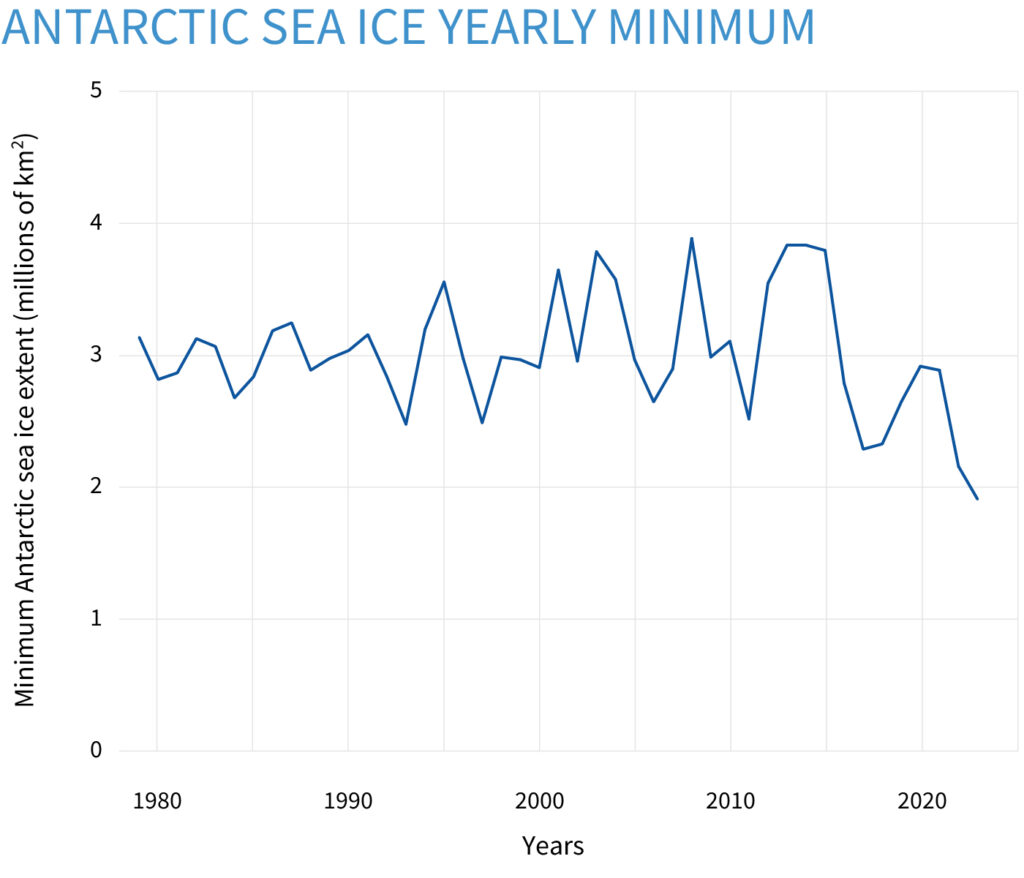Earth System Science Interdisciplinary Center (ESSIC) announced the selection of two recipients of the Seed Grant Program (ESGP), a new initiative to provide ESSIC scientists with internal funding mechanisms to carry out innovative research in pilot studies that have the strong potential to lead to future proposals for external funding.
The new program is aligned with the New Directions Fund of the Maryland Catalyst Fund (MCF) program, University of Maryland’s internal faculty research support program. The program is designed to enable innovative research, incentivize the pursuit of large, complex, and high-impact research initiatives, and help UMD faculty to be more competitive for extramural research awards. ESSIC will align the submission of the proposals to the annual call for the MCF, which is anticipated to be each spring.
This year’s grants were awarded to Senior Faculty Specialist Kyle Duncan and Associate Research Professor Michael Gerst.
All Change at the Poles: Investigating Rapid Sea Ice Loss in Antarctica
PI: Kyle Duncan

Since 2015, the Antarctic minimum sea ice extent – the area of the Southern Ocean covered by sea ice at the end of summer – has declined broadly and rapidly, diminishing by 53% in the past 8 years. Low sea ice levels would have major impacts on the climate system, including an increase in heat transfer between the atmosphere and ocean, driving a positive ice-albedo feedback loop, ocean salinity changes, disrupting global ocean circulation, habitat loss and changes to biological production in the ocean, causing extreme stress on the marine environment.
Despite this importance, in-situ observations in the Southern Ocean are sparse, and there is limited evidence and low agreement about the causes of the observed strong and rapid decreases in Antarctic sea ice extent, problems further exacerbated by low confidence in the ability of current climate models to reproduce and explain the observations. Continent-wide studies addressing the changes currently underway are urgently needed to understand why the ice is declining and how this might affect climate change.
Duncan proposes to address this urgent need by exploiting the new, highly-detailed observations from ICESat-2 to uncover how the ice is growing, deforming and disappearing around Antarctica.
Previously, Duncan and Sinead Farrell, Associate Professor at UMD’s Department of Geographical Sciences, developed the University of Maryland-Ridge Detection Algorithm (UMD-RDA) to derive height variations in sea ice surface topography from ICESat-2 data at ~3 m resolution. This algorithm has been applied to Arctic sea ice, but has not yet been employed to improve understanding of changes in Antarctic sea ice.
Duncan proposes an extension of UMD-RDA over Antarctic sea ice for a 5-year period, spanning 2018-2023, to produce the most complete dataset of Antarctic sea ice deformation known to date.
“ICESat-2 kickstarted a whole new era in polar research due to its ability to measure the Earth’s surface topography at extremely high resolution,” said Duncan, “With our new project we aim to apply our methods, previously used to investigate changes in Arctic sea ice, to Antarctic sea ice. Through our data analysis, we hope to unravel a critical piece of the puzzle as to why and how changes are occurring, and better understand the processes driving seasonal and inter-annual variability.”
This work will enable new collaborative partnerships between UMD and other researchers within the sea ice community, improving our understanding of the seasonal and inter-annual variability of sea ice deformation in Antarctica and uncovering new relationships between deformation, roughness, and ice extent to help guide the design of future satellite sensors.
“My biggest joy is seeing our datasets being used to help further other studies. It’s so amazing to me to see all the different applications of our data,” said Duncan “Through these collaborations we can link together different aspects of the sea ice cover, such as its fractional area, thickness, and drift velocity, which together will provide the insights needed to better understand these anomalous sea ice events.”
Improving Multidisciplinary Model-based Science Using Bayesian Confirmation Theory
PI: Michael D. Gerst
The process of finding solutions to global change problems has increasingly relied on linking
complex models from multiple disciplines. Using multidisciplinary model-based science at this scale introduces two challenges. The first is that each discipline has its own standards and norms with respect to model construction, verification, and translation into insight. The second is that the phenomena underlying global change are not always well understood, requiring modeling under deep uncertainty: a situation where there might not be one ‘true’ or well-defined predictions.
A lack of shared standards can lead to barriers in communicating model insights, leading to potential misuse of models and miscommunication to decision makers. Deep uncertainty introduces challenges in creating model experiments, interpreting results, and communicating implications of known and unknown unknowns.
“Scientists are not very good at communicating unknown known and unknown unknowns, which are often vaguely described in a paper’s discussion section, even though they are important for understanding risk,” said Gerst.
Gerst seeks to create a general procedure to make these unknowns more explicit, allowing scientists to better communicate their models’ capabilities to scientists from other disciplines. With this procedure, decision makers will have more and better information to make choices.
Gerst plans on developing the framework by bringing together two streams: Bayesian confirmation theory, an applied method from the philosophy of science designed to describe how scientists should learn from their experiments and models, and the psychology of expert judgment, which involves experimental work on how experts reason with uncertain information.
“The ideas behind this Seed Grant are new and unproven,” said Gerst, “The project will refine and test the concepts with a diverse set of scientists.”
When implemented, the framework will prescribe questions that modelers and model users should ask and provide guidance on how to answer them given what is known about the pitfalls of expert judgment.





